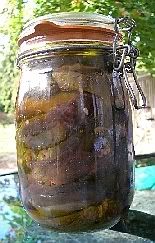Ramadan Mubarak
Ramadhan's a good time to take a break. I shall stop blogging awhile.
May I wish you all a peaceful month, and to my Muslim readers:

On Trengganuspeak and the Spirit of Trengganu
Ramadhan's a good time to take a break. I shall stop blogging awhile.

The light of winter is upon us so surely now, but even with our north-facing prospect the light's still coming in quite strongly even at tea. Twenty-ninth September isn't the time for picking blackberries, says an old English lore, as that's the time when they would have been spat on and cursed by the devil.
 the summer's now going too quickly. I'm comforted though by the work that's been done and for my bold attempt to try out a receipe sent me by my friend Aquacool. As you can see in the picture, my first attempt at home made makdous which I enjoyed this morning, drenched in olive oil, with Arab bread and flaked chilli. Thanks AquaCool!
the summer's now going too quickly. I'm comforted though by the work that's been done and for my bold attempt to try out a receipe sent me by my friend Aquacool. As you can see in the picture, my first attempt at home made makdous which I enjoyed this morning, drenched in olive oil, with Arab bread and flaked chilli. Thanks AquaCool!It is a useful rule of thumb that you don't ngellik behind something thinner than you. So you don't do it behind a bean-pole if you've been eating too many nekbat, but if you're wearing a shirt with stripes running down its front, you may get away with hiding behind many upright sticks that are of the same colour as your verticals. And you don't, as another useful rule, hide behind someone who is in the shape of an ayang ketik ttunga as that often describes a wasting sickness that is akin to our modern day anorexia.
For a time Sulong set up shop above Kedai Pök Che Amat, the man with vinegar reeking from his backroom and enough strings and ropes to stretch from Tanjong to Batu Rakit; and if on some bedevilled nights, high-pitched ngilla laughter issued in the moonlit air, Pök had enough nails in the front of his shop to rein in the whole cacophony of pontianaks back to civilian life. We lived in the comfort of Kedai Pök.
Sometimes it is better to netter than just to hang around, but nettering can also give rise to loitering with intent, which abruptly raises a frown and degrades it into another social dimension.
In his journey to Central America (written in 1985) Patrick Marnham wrote of fires burning in 'Nestlé thuribles' on the steps of two imposing Catholic chruches in the famous market square in Chichicastenango, Guatemala.
"In the market there are stalls cluttered with used Nestlé milk tins which have been perforated with a skewer and threaded with a wire handle."Many men (and women) walked around our market square in Tanjong in my day, all bearing steaming thuribles marked with the word Nestlé. Many more were emblazoned with the labels of Cap Api (torch), or Pitis (coins) or the then ubiquitous Dutch Baby. These were milk tins, emptied and re-used as takeaway containers for kopi susu or 'o' or our teh tarik dear. The tea-sellers opened their milk tins by cutting around the inner edge of the top but leaving about an inch or two still connected to the tin, to act as a 'hinge' for what was now the top flap through which a hole was punched. A looped raffia or hemp string was then pushed through this hole for you to hook your index finger.
Gguling galök is difficult to do with things in your head, but when you're in the heat of it with head tumbling over your heels, you sometimes forget what it was that caused you to do the gguling in the first place.
We had a man named Bachok who climbed a coconut tree whole and climbed down again with the tree tumbling in his wake. He was a legendary trimmer-down of coconut trees, an art that he acquired in his native Sulawesi (Celebes). We had Pat Mat Perancis who went out to sea to fish, and whose blue eyes are still seen in his progeny of the day. There was a refugee Bosnian doctor who drifted to our midst and was finally laid to rest in the Kubur Sheikh Ibrahim. There are Arab-Yemeni families extant on our monsoon-blown shores, and Habaib families that paddled upstream to the Kualas Telemong and Brang, one of whom carved out in stone — as some believe — the letters of the law of the Batu Bersurat in the hazy mists of the 14th century.